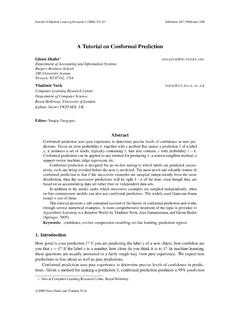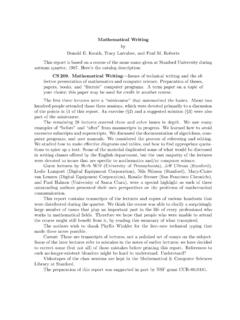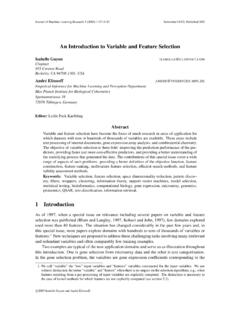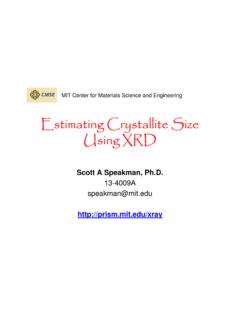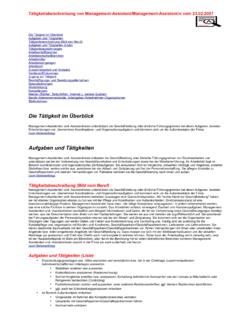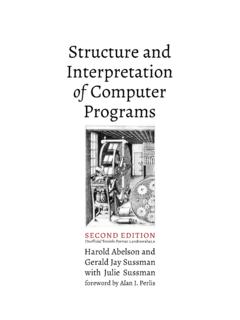Transcription of Random Search for Hyper-Parameter Optimization
1 Journal of Machine Learning Research 13 (2012) 281-305 Submitted 3/11; Revised 9/11; Published 2/12 Random Search for Hyper-Parameter OptimizationJames epartement d Informatique et de recherche op erationnelleUniversit e de Montr ealMontr eal, QC, H3C 3J7, CanadaEditor:Leon BottouAbstractGrid Search and manual Search are the most widely used strategies for Hyper-Parameter optimiza-tion. This paper shows empirically and theoretically that randomly chosen trials are more efficientfor Hyper-Parameter Optimization than trials on a grid. Empirical evidence comes from a compar-ison with a large previous study that used grid Search and manual Search to configure neural net-works and deep belief networks. Compared with neural networks configured by a pure grid Search ,we find that Random Search over the same domain is able to find models that are as good or betterwithin a small fraction of the computation time. Granting Random Search the same computationalbudget, Random Search finds better models by effectively searching a larger, less promising con-figuration space.
2 Compared with deep belief networks configured by a thoughtful combination ofmanual Search and grid Search , purely Random Search over thesame 32-dimensional configurationspace found statistically equal performance on four of seven data sets, and superior performanceon one of seven. A Gaussian process analysis of the function from hyper-parameters to validationset performance reveals that for most data sets only a few of the hyper-parameters really matter,but that different hyper-parameters are important on different data sets. This phenomenon makesgrid Search a poor choice for configuring algorithms for new data sets. Our analysis casts somelight on why recent High Throughput methods achieve surprising success they appear to searchthrough a large number of hyper-parameters because most hyper-parameters do not matter anticipate that growing interest in large hierarchical models will place an increasing burden ontechniques for Hyper-Parameter Optimization ; this work shows that Random Search is a natural base-line against which to judge progress in the development of adaptive (sequential) hyper-parameteroptimization :global Optimization , model selection, neural networks, deep learning, response surfacemodeling1.
3 IntroductionThe ultimate objective of a typical learning algorithmAis to find a functionfthat minimizes someexpected lossL(x;f)over samplesxfrom a natural (grand truth) distributionGx. AlearningalgorithmAis a functional that maps a data setX(train)(a finite set of samples fromGx) to a functionf. Very often a learning algorithm producesfthrough the Optimization of a training criterion withrespect to a set ofparameters . However, the learning algorithm itself often has bells and whistlescalledhyper-parameters , and the actual learning algorithm is the one obtained after choosing , which can be denotedA , andf=A (X(train))for a training setX(train). For example, with ac 2012 James Bergstra and Yoshua ANDBENGIOG aussian kernel SVM, one has to select a regularization penaltyCfor the training criterion (whichcontrols the margin) and the bandwidth of the Gaussian kernel, that is, = (C, ).What we really need in practice is a way to choose so as to minimize generalization errorEx Gx[L(x;A (X(train)))].
4 Note that the computation performed byAitself often involves an inneroptimization problem, which is usually iterative and approximate. The problem ofidentifying agood value for hyper-parameters is called the problem ofhyper-parameter Optimization . Thispaper takes a look at algorithms for this difficult outer-loop Optimization problem, which is of greatpractical importance in empirical machine learning work: ( )=argmin Ex Gx[L(x;A (X(train)))].(1)In general, we do not have efficient algorithms for performing the Optimization implied by Equa-tion 1. Furthermore, we cannot even evaluate the expectation over the unknown natural distributionGx, the value we wish to optimize. Nevertheless, we must carry out this Optimization as best wecan. With regards to the expectation overGx, we will employ the widely used technique ofcross-validationto estimate it. Cross-validation is the technique of replacing the expectation with a meanover avalidation setX(valid)whose elements are drawn Gx.
5 Cross-validation is unbiasedas long asX(valid)is independent of any data used byA (see Bishop, 1995, pp. 32-33). We see inEquations 2-4 the Hyper-Parameter Optimization problem as it is addressed inpractice: ( ) argmin meanx X(valid)L(x;A (X(train))).(2) argmin ( )(3) argmin { (1).. (S)} ( ) (4)Equation 3 expresses the Hyper-Parameter Optimization problem in terms of ahyper-parameterresponse function, . Hyper-Parameter Optimization is the minimization of ( )over . Thisfunction is sometimes called theresponse surfacein the experiment design literature. Different datasets, tasks, and learning algorithm families give rise to different sets and functions . Knowingin general very little about the response surface or the Search space , the dominant strategy forfinding a good is to choose some number (S) oftrialpoints{ (1).. (S)}, to evaluate ( )for eachone, and return the (i)that worked the best as . This strategy is made explicit by Equation critical step in Hyper-Parameter Optimization is to choose the set of trials{ (1).}
6 (S)}.The most widely used strategy is a combination of grid Search and manual Search ( , LeCunet al., 1998b; Larochelle et al., 2007; Hinton, 2010), as well as machine learning software packagessuch as libsvm (Chang and Lin, 2001) and is a set indexed byKconfigurationvariables ( , for neural networks it would be the learning rate, the number of hidden units, thestrength of weight regularization, etc.), then grid Search requires that we choose a set of values foreach variable (L(1)..L(K)). In grid Search the set of trials is formed by assembling every possiblecombination of values, so the number of trials in a grid Search isS= Kk=1|L(k)|elements. Thisproduct overKsets makes grid Search suffer from thecurse of dimensionalitybecause the numberof joint values grows exponentially with the number of hyper-parameters (Bellman, 1961). : Machine Learning in Python can be found FORHYPER-PARAMETEROPTIMIZATION Search is used to identify regions in that are promising and to develop the intuition necessary tochoose the setsL(k).
7 A major drawback of manual Search is the difficulty inreproducing is important both for the progress of scientific research in machine learning as well as for easeof application of learning algorithms by non-expert users. On the other hand, grid Search alone doesvery poorly in practice (as discussed here). We propose Random Search as a substitute and baselinethat is both reasonably efficient (roughly equivalent to or better than combinining manual searchand grid Search , in our experiments) and keeping the advantages of implementation simplicity andreproducibility of pure grid Search . Random Search is actually more practical than grid searchbecause it can be applied even when using a cluster of computers that canfail, and allows theexperimenter to change the resolution on the fly: adding new trials to the setor ignoring failedtrials are both feasible because the trials are , which is not the case for a grid Search .
8 Of course, Random Search can probably be improved by automating what manual Search does, , a sequentialoptimization, but this is left to future are several reasons why manual Search and grid Search prevail as the state of the art despitedecades of research into global Optimization ( , Nelder and Mead, 1965;Kirkpatrick et al., 1983;Powell, 1994; Weise, 2009) and the publishing of several Hyper-Parameter Optimization algorithms( , Nareyek, 2003; Czogiel et al., 2005; Hutter, 2009): Manual Optimization gives researchers some degree of insight into ; There is no technical overhead or barrier to manual Optimization ; Grid Search is simple to implement and parallelization is trivial; Grid Search (with access to a compute cluster) typically finds a better than purely manualsequential Optimization (in the same amount of time); Grid Search is reliable in low dimensional spaces ( , 1-d, 2-d).We will come back to the use of global Optimization algorithms for Hyper-Parameter selectionin our discussion of future work (Section 6).
9 In this paper, we focus onrandom Search , that is, inde-pendent draws from a uniform density from the same configuration space as would be spanned by aregular grid, as an alternative strategy for producing a trial set{ (1).. (S)}. We show that randomsearch has all the practical advantages of grid Search (conceptual simplicity, ease of implementation,trivial parallelism) and trades a small reduction in efficiency in low-dimensional spaces for a largeimprovement in efficiency in high-dimensional Search this work we show that Random Search is more efficient than grid Search in high-dimensionalspaces because functions of interest have alow effective dimensionality; essentially, of interestare more sensitive to changes in some dimensions than others (Caflisch et al.,1997). In particular, ifa functionfof two variables could be approximated by another function of one variable(f(x1,x2) g(x1)), we could say thatfhas alow effective dimension.
10 Figure 1 illustrates how point gridsand uniformly Random point sets differ in how they cope with low effective dimensionality, as inthe above example withf. A grid of points gives even coverage in the original 2-d space, butprojections onto either thex1orx2subspace produces an inefficient coverage of the subspace. Incontrast, Random points are slightly less evenly distributed in the original space, but far more evenlydistributed in the the researcher could know ahead of time which subspaces would be important, then he or shecould design an appropriate grid. However, we show the failings of this strategy in Section 2. For a283 BERGSTRA ANDBENGIOGrid LayoutRandom LayoutUnimportant parameterImportant parameterUnimportant parameterImportant parameterFigure 1: Grid and Random Search of nine trials for optimizing a functionf(x,y) =g(x) +h(y) g(x)with low effective dimensionality. Above each squareg(x)is shown in green, andleft of each squareh(y)is shown in yellow.
